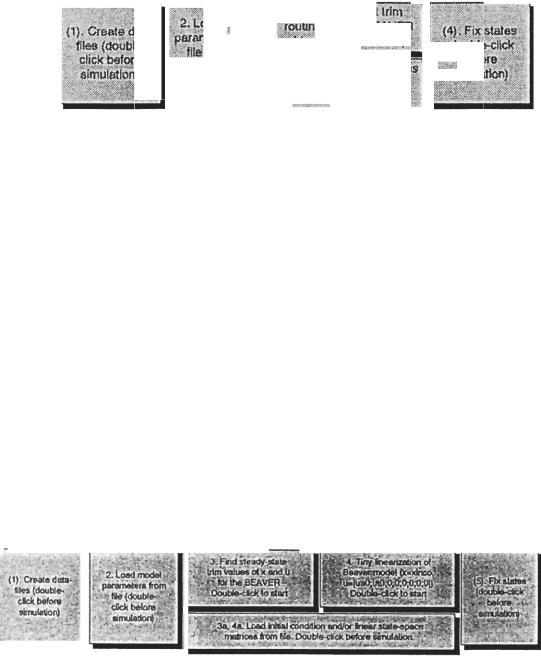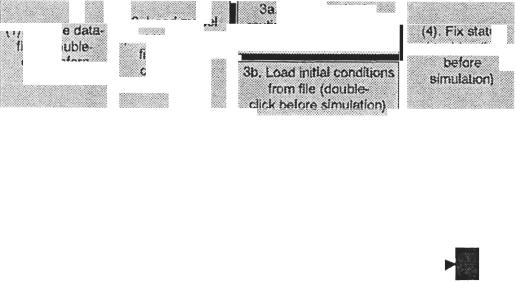
Thesis - Beaver simulation
.pdf

l nitial inputs for aeromod
Initial inputs for engmod
1 Scope
|
|
|
aircraft model |
Auto-scale stora |
|
I |
( w d o t ,l |
Graph Scope |
|
|
|
|
||
I |
'I |
|
|
|
|
wDrydenl |
wwdot |
|
|
Figure 6-3. Block-diagram of the system OLOOP2 (nonlinear open-loop simulation model for atmospheric disturbances)
Chapter 6 |
109 |
Conclusions part I.
In this report, a SIMULINKenvironment for aircraft dynamics and control analysis has been presented. This environment contains a modular nonlinear aircraft model, several submodels for atmospheric disturbances and the calculation of radio-navigation signals, and some helpprograms for the determination of steady-state flight conditions and linearized state-space models of the aircraft. The environment has been applied to the 'Beaver', but due to its modular structure, it is relatively straightforward to implement models of other aircraft.
The SIMULINKtools from this report are particulary useful for application in the field of Automatic Aircraft Control Systems (AACS) design and analysis, because they fully integrate the complete linear control system design and the nonlinear off-line AACS-analysis. This is very important because of the iterative character of the AACS development process. Moreover, since the complete range of MATLAB toolboxes can be accessed from this environment, applications for system identification and the analysis of flight-test results are within reach.
The models have been validated by means of some open-loop responses to several inputs, including atmospheric turbulence. The responses are consistent with results from the DUT-flightsimulator software, so it can be concluded that the systems have been implemented correctly. Open-looprespon- ses of the linearized models have been created too,to demonstrate the capabilities of the aircraft trim and linearization tools. Compared to ref.[25], the new models are f a r more flexible, and also much faster.
The tools do require sufficient computer capacity in order to be able to perform simulations of the aircraft, equipped with a digital controller, or affected by noisy disturbances such as atmospheric turbulence, within a reasonable time. For most purposes, a 486 PC running at 33 MHz or more will suffice. Really sophisticated models will probably need the power of modem workstations.
In the nearby future, the National Fly-by-wirv Testbed projects for the new Cessna Citation I1 laboratory aircraft will certainly require the flexibility and power of the SIMULINKenvironment in order to be able to set new standards for fly-by-wirecontrol research. It will not be sufficient to focus on the hardware and software equipment of the aircraft only.
Recomnendat ions |
113 |
Recommendations.
The environment for aircraft dynamics and control analysis, presented in this report needs to be developed further into a more general simulation structure in an arbitrary aircraft dynamics model can be implemented with
a |
minimum |
of programming efforts. Due to the flexibility of the MAT- |
|
L |
A B / |
S environment,~ |
tirne-consuming conversions from linear system |
analysis in MATLABto nonlinear system analysis in Fortran will be eliminated completely, thus reducing the chances of making conversion errors.
The only conversions that will remain are the steps from off-line system analysis on a PC or workstation to on-lineanalysis in a real-time flightsirnulator, and the step from control system design on a PC to implementation of control laws in the Flight Control Computers of the real aircraft. With regard to the assessment of control laws for autopilots or fly-by-wire systems, it is highly recommendable to smooth-out these conversions as much as possible by developing flexible interfaces between the SIMULINKenvironment and the flightsimulator or the FCCs respectively.
It is recommended to collect all dynamic SIMULINKmodels, developed in the Disciplinary group for Stability and Control in standardized model-libraries, stored on a centralized workstation which can be accessed by way of a computer network. If these models are properly managed, it can be made sure that all persons which are involved in a particular research project are always provided with the most up-to-date versions of the models. Also, it can be prevented that everyone has to re-invent the wheel again for each new project is started. If standardized definitions of reference frames and/or lists of symbols are created too,many misunderstandings can be eliminated.
References |
115 |
References.
Anon. Approach and Landing Simulation. AGARD report 632, Ames, 1975.
Anon. International Standards and Recommended Practices. Annex 10, Volume I, Part I: Equipment and Systems and Attachment C to Part I, ICAO, Montreal, Canada, 1968.
Anon. PC-MATLABUser's Guide. The Mathworks Inc., Natick, Massachusetts, USA,
1989.
Anon. SIMULINK,a program for simulating dynamic systems. User's Guide, The Mathworks Inc., Natick, Massachusetts, USA, 1992.
Abbink, F.J.: VliegtuiginstrumentatieI / II (in Dutch). Lecture Notes D-27/D-31, Delft University of Technology (Aerospace Engineering), Delft, 198411983.
Baarspul, M.: Lecture Notes on Flight Simulation Techniques. Report LR-596, Delft University of Technology (Aerospace Engineering), Delft, 1989.
Bauss, W. (editor): Radio Navigation Systems for Aviation and Maritime Use.
AGARDograph 63, Pergamon Press, UK, 1963.
Bosch, P.P.J. van den, Klauw, A.C. van der: Modelling, Identification and Simulation of Dynamical Systems. Lecture notes 187, Delft University of Technology (Electrical Engineering), Delft, edition 1992.
Chen, Chi-Tsong: Linear system theory and design. Holt, Rinehart and Winston Inc., USA, 1984.
Colgren, R.D.: A workstation for the integrated design and simulation of flight control systems. Lockheed Aeronautical Systems Company, Burbank, California, USA.
Duke, E.L., Antoniewicz, R.F., Krambeer, K.D.: Derivation and Definition of a Linear Aircraft model. NASA Reference Publication 1207, USA, 1988.
Etkin, B.: Dynamics of Flight; Stability and Control. Wiley, New York, USA, 2ndedition, 1982.
Fogarty, L.E., Howe, R.M.: Computer mechanization of six-degree of freedom flight equations. NASA Contractor Report 1344, USA, 1969.
Forsythe, G.E., Malcolm, M.A., Moler, C.B.: Computer Methods for Mathematical Computations. Prentice Hall, Englewood Cliffs, New Jersey, USA, 1977.
Gear, C.W.: Numerical Initial Value Problems i n Ordinary Differential Equations.
Prentice Hall, Englewood Cliffs, New Jersey, USA, 1971.
Gerlach, O.H., Mathematical model of external disturbances acting on an aircraft during an ILS approach and landing. Report VTH-159, Delft University of Technology (Aerospace Engineering), Delft, 1970.
Gerlach, O.H., Lecture Notes on Aircraft Stability and Control. Lecture notes D-26, Delft University of Technology (Aerospace Engineering), Delft, 1981.
Gobardhan, S.: Het overzetten van het niet-lineaire model van de 'Beaver' ( R e m m e r s w d ) i n de structuur, zoals toegepast door Hermansyah bij de implementatie van de F28 (In Dutch). Interim report, Delft University of Technology (Aerospace Engineering), Delft, 1989.
Hoogstraten, J.A., Van de Moesdijk, B.: Modular programming structure applied to the simulation of rwn-linear aircraft models. In: IMACS Conference Proceedings on 'Simulation in Engineering Sciences', Nantes, France, 1983.
Johnson, W.A., McRuer, D.T.: Development of a Category 11Approach System Model.
NASA Contractor Report 2022, Washington D.C., USA, 1972.
Kendal, B.: Manual of avionics. BSP Professional Books,UK, 2ndedition, 1987.
McLean, D.: Automatic Flight Control Systems. Prentice Hall international, Hertfordshire, UK, 1990.
McRuer, D., Ashkenas, I., Graham, D.: Aircraft Dynamics and Automatic Control.
Princeton University Press, Princeton, New Jersey, USA, 1973.
Mulder, J.A., Van der Vaart, J.C.: Aircraft Responses toAtmospheric Turbulence. Lecture notes D-47, Delft University of Technology (Aerospace Engineering), Delft, edition 1992.
Rauw,M.0.: Using SIMULINKfor Nonlinear Analysis of Aircraft Control Systems. Interim report, Delft University of Technology (Aerospace Engineering), Delft, 1992.
Rolfe, J.M., Staples, K.J. (editors): Flight Simulation. Aerospace Series, Cambridge University Press, Cambridge, UK, 1986.
Ruijgrok, G.J.J.: Elements of airplane performance. Delft University Press, Delft, 1990.
Stengel, R.F., Sircar, S.: Computer-AidedDesign of Flight Control Systems. AIAA-91- 2677-CP, Princeton, New Jersey, USA, 1991.
Stevens, B.L., Lewis, F.L.: Aircraft Control and Simulation. John Wiley & Sons Inc., 1992.
Tjee, R.T.H., Mulder, J.A.: Stability and Control Derivatives of the De Havilland
DHC-2 Beaver' aircraft. Report LR-556, Delft University of Technology (Aerospace Engineering), Delft, 1988.
Tomlinson, B.N., Padfield, G.D., Smith, P.R.: Computer-Aided control law research; From concept to flight test. In: AGARD conferenc'e proceedin= on 'Computer Aided Svstem Design and Simulation', AGARD CP-473, London, 1990.
